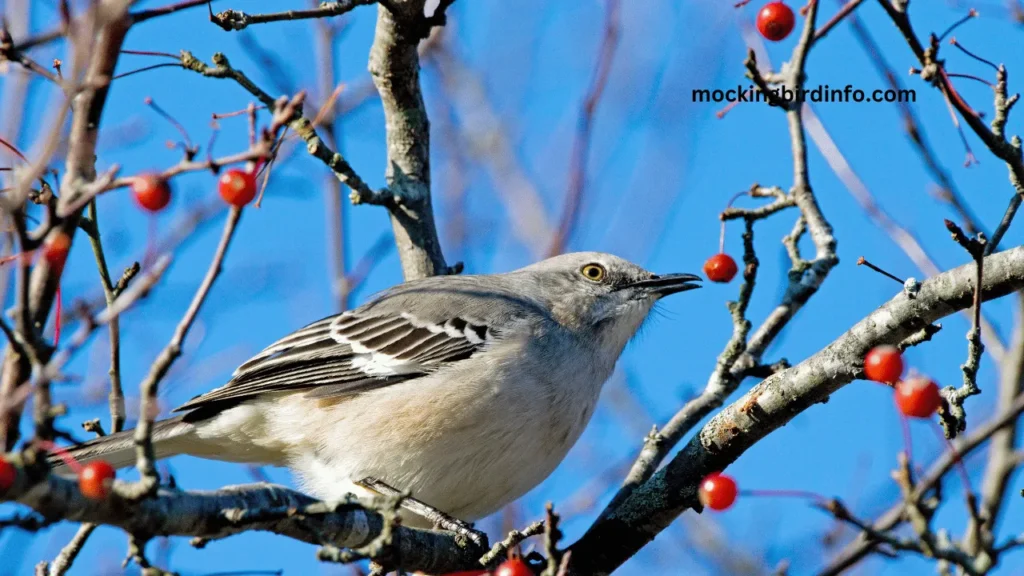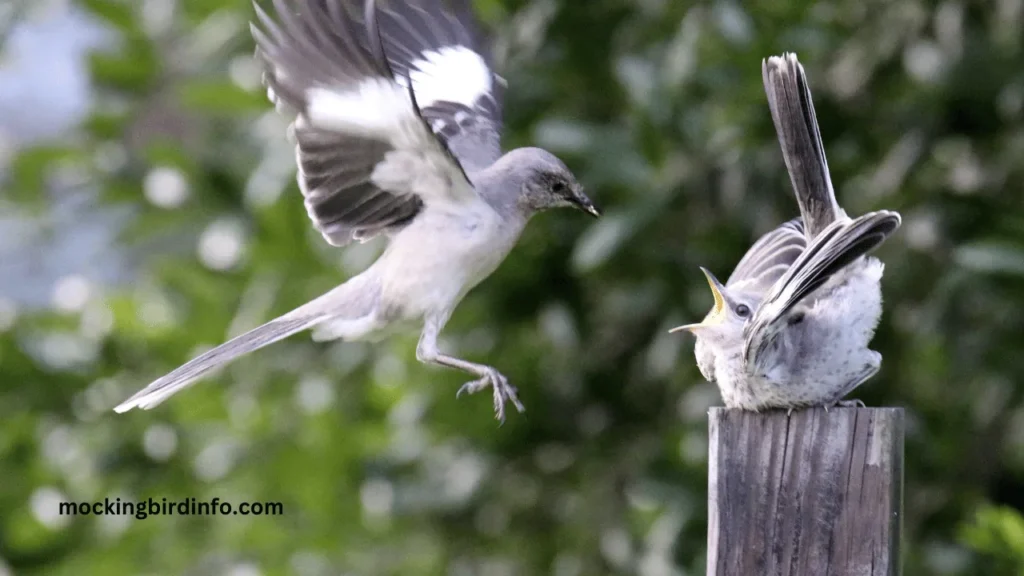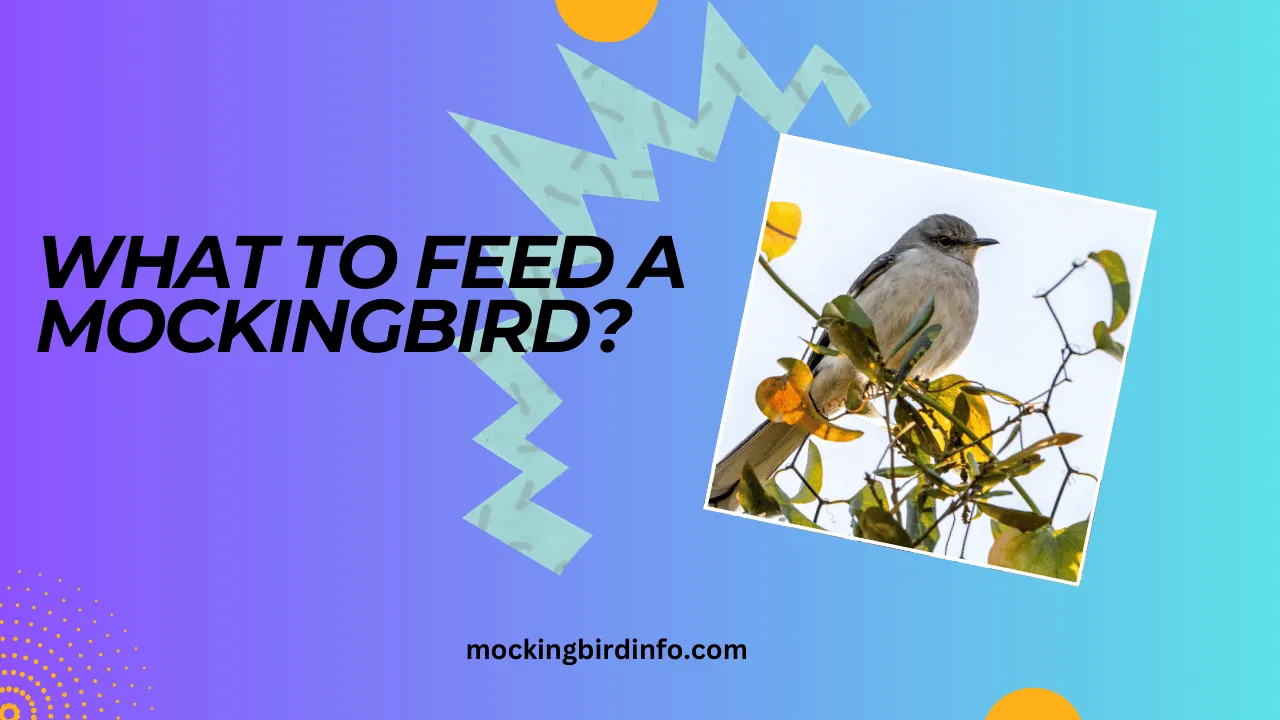Mockingbirds are celebrated for their ability to mimic the calls of other birds, animals, and even mechanical sounds, making them one of the most captivating birds to have around. If you’ve ever witnessed a mockingbird performing an elaborate medley of chirps and melodies, you know how special they are.
Ensuring that these songbirds have the proper diet can keep them coming back and help maintain their health. Feeding them appropriately is not just about scattering a handful of seeds; it involves understanding their natural diet and creating an inviting environment that encourages them to thrive.
Feeding mockingbirds helps support their overall well-being, especially during the harsher months when their natural food sources are limited. This article will explore what mockingbirds eat in the wild, suitable foods you can provide, ways to create a bird-friendly space, potential challenges, and common questions about feeding these birds.

Contents
Natural Diet of Mockingbirds
Mockingbirds are omnivorous, which means they consume a wide range of foods for a balanced diet. Here’s an in-depth look at what they eat naturally:
- Insects: The most significant part of a mockingbird’s diet consists of insects and small invertebrates. They are especially fond of grasshoppers, beetles, caterpillars, and spiders. These insects provide essential proteins, which are critical during the breeding season to support growth and energy.
Mockingbirds are known for foraging on the ground and in shrubs, actively hunting these tiny creatures. - Fruits and Berries: When insects are not as plentiful, mockingbirds turn to fruits and berries for sustenance. They are particularly attracted to mulberries, elderberries, blackberries, and holly berries. Fruits provide essential vitamins, sugars, and hydration. Berries also help them maintain energy during migration or in colder weather.
- Seeds: While not a staple, seeds can still be part of their diet. Sunflower seeds, millet, and thistle seeds offer additional nutrition, especially in winter when other food is scarce. However, seeds should be given alongside other food options to provide variety.
Suitable Supplemental Foods
Providing additional food can help support mockingbirds, especially during seasons when their natural diet is less accessible. Here’s what you can safely offer:
- Commercial Birdseed: Mockingbirds may not prioritize seed mixes designed for other species, but they do enjoy black oil sunflower seeds, which are packed with healthy fats. Nyjer seeds can also be offered, though these are more commonly associated with finches. Suet, a mix of animal fat and seeds, is particularly beneficial during colder months as it provides a dense energy source.
- Mealworms: Offering live or dried mealworms is an excellent way to mimic their natural insect diet. Mealworms are rich in protein and can be placed in a shallow dish or platform feeder to attract them.
- Homemade Treats: Creative treats like mealworm bread—a simple mixture of flour, water, and mealworms—can provide novelty and essential nutrients. Another option is to string together a fruit kabob with grapes, apple slices, and berries. These treats can be hung from trees or placed on feeders.
- Water Sources: Mockingbirds need clean, fresh water for both drinking and bathing. Especially during dry or hot weather, water can be as crucial as food. A shallow birdbath with a gentle slope is ideal. Ensure that it’s cleaned regularly to prevent the spread of bacteria and algae buildup.

Creating a Bird-Friendly Environment
Beyond food, the environment plays a crucial role in attracting mockingbirds. Here’s how to make your yard more inviting:
- Planting Native Shrubs and Trees: Native plants are a cornerstone for bird-friendly landscaping. They attract native insects that mockingbirds eat and produce berries and fruit that they love. Examples include mulberry trees, serviceberry bushes, and hawthorn. These plants not only provide food but also shelter and nesting sites.
- Providing Shelter: Mockingbirds are territorial and prefer secure areas for nesting and roosting. Dense shrubs like holly and juniper provide cover and protection from predators. If you live in an area with harsh weather, consider planting evergreen shrubs that maintain their structure throughout the year.
- Avoiding Pesticides: Pesticides and insecticides can eliminate the very insects that mockingbirds depend on. Furthermore, chemicals can be toxic if ingested directly or indirectly through their food. Using natural pest control methods, like companion planting and attracting beneficial insects, helps maintain a balanced ecosystem.
- Installing Nesting Shelters: While mockingbirds often build their own nests in dense vegetation, having nesting boxes with open fronts can encourage them to stay if they don’t find suitable trees or shrubs. Position the boxes in sheltered areas to provide extra safety.
Potential Risks and Considerations
Feeding birds should always be done with a clear understanding of potential risks to ensure the birds’ health and the safety of your property:
- Overfeeding: Mockingbirds, like other wildlife, can become dependent on food sources that humans provide. Over-relying on these can lead to a reduction in their natural foraging behavior. This dependency can make them more vulnerable if the food source is suddenly removed and may lead to obesity or poor nutrition if the diet lacks variety.
- Attracting Unwanted Pests: Leaving food out can sometimes invite unwanted visitors such as rodents, raccoons, and squirrels. These pests can disrupt the ecosystem and cause damage. To mitigate this, ensure that food is presented in feeders that minimize spillage and clean the ground of uneaten food regularly.
- Disease Transmission: Birds that congregate at feeders or water sources are at risk of transmitting diseases like avian pox and salmonellosis. To prevent this, clean feeders and birdbaths frequently with a mild bleach solution, rinse thoroughly, and allow them to dry before refilling.
Conclusion
Feeding mockingbirds is a rewarding experience that enhances your connection with nature while supporting local wildlife. By understanding what they eat in the wild and supplementing their diet with nutritious, safe foods, you can create an inviting environment that encourages their presence.
Whether you choose to plant native trees, offer mealworms, or set up birdbaths, each effort you make contributes to the health and happiness of these songbirds.
The key is balance. Providing food should complement their natural diet, not replace it. As you attract mockingbirds to your yard, remember to observe their behavior, note their preferences, and make adjustments as needed to ensure their continued visits and well-being.
FAQs
1. What is the best food to attract mockingbirds?
Protein-rich insects like mealworms, and fruits such as berries and grapes, are excellent. Black oil sunflower seeds and suet can also be beneficial.
2. Can mockingbirds eat bread?
Bread offers minimal nutrition and can cause digestive issues. It’s better to avoid bread and stick to nutrient-rich options like fruits and mealworms.
3. Do mockingbirds need water?
Yes, water is essential for both drinking and bathing. Providing a shallow, clean birdbath can attract mockingbirds, especially during dry periods.
4. What fruits do mockingbirds enjoy most?
Mockingbirds are fond of grapes, cherries, and various berries, such as mulberries and blackberries.
5. Is suet a good food for mockingbirds?
Yes, suet is rich in fats and helps provide energy, especially in colder weather when they need more calories to maintain body heat.
6. How can I make my yard more attractive to mockingbirds?
Plant native shrubs, provide dense shelter, ensure a fresh water source, and avoid pesticides to make your yard a haven for them.








